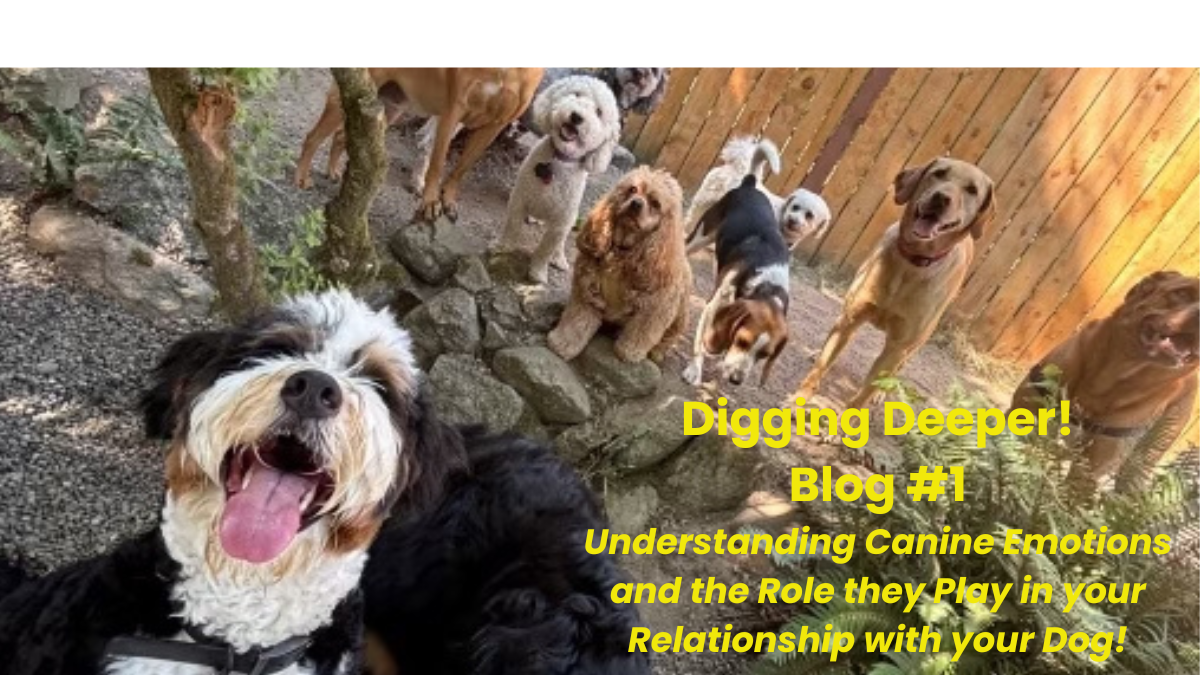Understanding Canine Emotions: The Heart of the Human-Dog Bond

Learning about canine emotions and body language will help you have better understanding about what they do and why they do it.
Understanding Canine Emotions: The Heart of the Human-Dog Bond
Have you ever looked into your dog's eyes and thought, "I know exactly what you're feeling right now"? That special connection isn't just your imagination—it's backed by science! Understanding our dogs' emotional lives isn't just fascinating; it's the cornerstone of building a relationship based on trust, respect, and effective training. Let's dig in!
Dogs Have Real Emotions (But They're Not Tiny Humans)
First things first: dogs absolutely experience emotions. Research has confirmed that dogs have emotional capacities similar to a human toddler—they experience joy, fear, anger, disgust, love, and even jealousy. However, their emotional experience isn't exactly like ours.
Dogs live in a world dominated by scent, immediate experiences, and social connections. They don't ruminate about the past or worry about tomorrow's vet appointment. Their emotions are genuine but exist in the present moment—which is actually something we humans could learn from!
Reading Your Dog's Emotional Language
Dogs are constantly telling us how they feel, but they're using a different language. Here's a quick translator's guide:
- Body posture: A loose, wiggly body means happiness and comfort. A stiff, still posture signals fear or anxiety.
- Tail position: It's not just about wagging! A high tail can signal alertness or arousal, while a tucked tail means fear.
- Facial expressions: Relaxed eyes and a soft mouth show contentment. Whale eye (showing whites) and tight lips suggest stress.
- Vocalizations: From happy grumbles to anxious whines, dogs have a rich vocal vocabulary.
Learning to read these cues gives us incredible insight into our dogs' emotional states and helps us respond appropriately.
The Emotional Foundation of Training
Here's where understanding canine emotions transforms our training approach. Traditional training methods often relied on punishment and dominance—approaches that leverage fear and intimidation. But we now know this doesn't just damage our relationship with our dogs; it's also less effective than positive reinforcement training.
When we use positive reinforcement, we create a training environment where dogs feel:
- Safety: "I can try new things without fear of punishment"
- Joy: "Learning is fun and rewarding!"
- Confidence: "I understand what's expected and can succeed"
- Trust: "My person is predictable and fair"
These positive emotional states create a brain that's literally more receptive to learning. Science shows that stress hormones inhibit learning, while positive emotions enhance cognitive function and memory formation. They can even grow new neural pathways!
The Emotional Bank Account
I like to think of our relationship with our dogs as an emotional bank account. Every positive interaction makes a deposit; every negative experience makes a withdrawal. With positive reinforcement training, we're constantly making deposits:
- Treating our dogs with respect
- Providing clear communication
- Rewarding desired behaviors
- Creating fair, achievable challenges
- Understanding and accommodating their needs
When we occasionally need to ask something difficult of our dogs—like enduring a scary thunderstorm or meeting a new veterinarian—we've built up enough emotional "capital" that our relationship remains strong.
Emotions Drive Behavior
Remember that all behavior serves a purpose, and that purpose is often emotional. When your dog jumps on guests, they're expressing excitement and seeking connection. When they growl at the vacuum cleaner, they're expressing fear of something unpredictable and loud.
Positive reinforcement training acknowledges these emotional drivers instead of just suppressing the resulting behaviors. We can then:
- Address the underlying emotion (gradually desensitizing to the vacuum)
- Teach alternative behaviors that fulfill the same emotional need (sitting for greeting to get attention)
The Sunflower Approach
At Confident Paws, I like to use what I call the "Sunflower Approach" to emotional development in dogs. Like sunflowers that need the right conditions to grow and flourish, dogs need:
- Solid roots: Basic needs met and feeling secure
- Strong stem: Clear boundaries and consistent guidance
- Facing the sun: Orientation toward positive experiences
- Room to grow: Freedom to make choices and learn from them
When these elements are in place, dogs naturally turn toward the positive and away from the negative—just like sunflowers following the sun.
Building Your Emotional Connection
Want to strengthen your emotional bond with your dog? Try these simple practices:
- Take five minutes daily for unstructured positive interaction
- Learn your dog's subtle stress signals and respect them
- Find what truly motivates your dog and use it generously in training
- Celebrate small successes—yours and your dog's
- View "mistakes" as information, not failures
- Practice patience and remember that emotions take time to change
The Bottom Line
Understanding your dog's emotions isn't just about being a more compassionate pet parent—it's about being a more effective trainer and building a relationship that enhances both your lives. When dogs feel good, they learn better, cooperate more willingly, and bond more deeply.
"From the relationship comes the results!" When we build training on a foundation of emotional connection and understanding, both the journey and the destination become more rewarding.
Ginger Morris is a KPA-CTP certified positive reinforcement dog trainer and the founder of Confident Paws Dog Training. She specializes in helping dogs and their people build stronger relationships by bringing clarity to the root of the undesired behavior instead of suppressing symptoms of a bigger issue. She uses simple pattern-based games to build confidence and joy in the dog and their handler. This approach reduces frustration and inspires creativity. making training being both effective and fun!
 Ginger Morris
Ginger Morris 